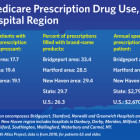Environmental Health
Is Corrosive Groundwater Leaching Lead Into Your Well Water?
|
Connecticut is one of 11 states with a very high prevalence of potentially corrosive groundwater, increasing the risk that water running out of the taps of homes with private wells might be tainted with lead, a study conducted by the U.S. Geological Survey (USGS) found. USGS researchers analyzed nearly three decades of data from more than 20,000 public and private wells nationwide and determined that between 75.3 percent and 84.9 percent of wells in Connecticut could contain corrosive groundwater. If left untreated, corrosive groundwater can leach lead and other metals in pipes en route to the tap, raising health concerns for the estimated 871,000 state residents who rely on private wells as their primary source of drinking water. In Connecticut, the state does not mandate or conduct testing of well water, instead relying on private well owners to maintain, test and treat their own wells. Many well owners are not aware of the risks of corrosion, environmental health activists say.
